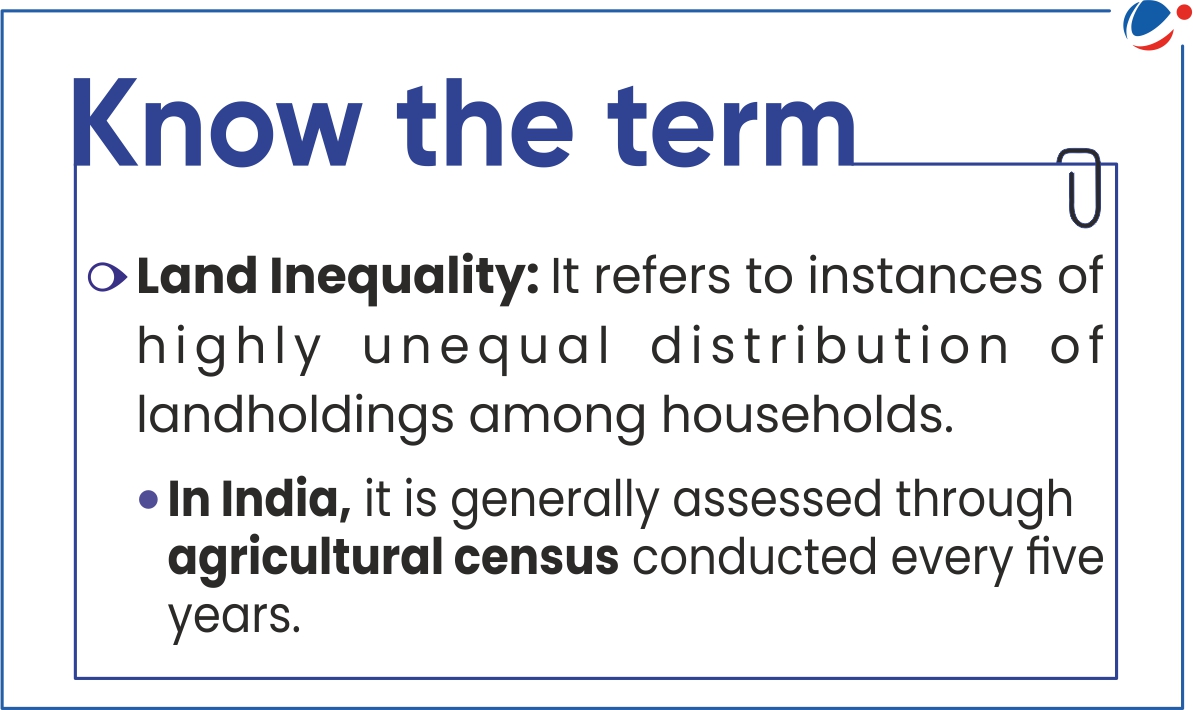Why in the News?
A report, titled 'Land Squeeze' has been released by the International Panel of Experts on Sustainable Food Systems (IPES-Food) showcases pressures on land leading to land inequality in India and across the globe.
More on the News
- IPES-Food is a global think-tank which provides expert guidance for sustainable food systems around the world.
- The report highlights how land across the world is facing a series of unprecedented pressures leading to squeezing of land and driving land inequality.
Key Highlights of the report

- Global:
- Land inequality: 1% of world's largest farms now control 70% of world's farmland.
- Price volatility: Between 2008 and 2022, land prices have nearly doubled globally and tripled in Central-Eastern Europe.
- India:
- Land inequality: Top 10% of landowners own 45% of farmland in India.
- Land degradation: >70% of India's arable land is undergoing one or more forms of land degradation.
Drivers of Land Squeeze
- Land Grabbing: Appropriation of land through the privatization of common land with instruments such as lease, concessions, quotas. This includes-
- Deregulation: Governments deregulating their land markets and adopt pro-investor policies. E.g., for creation of 'special economic zones' and 'growth corridors'.
- Financialization: Land ownership transferred from farmers to financial actors
- 'Water grabs' and 'resource grabs': Land deals focused on rapid resource extraction (e.g. through water-intensive cash cropping).
- Green Grab: Appropriation of land through top-down conservation schemes. E.g. for Carbon and biodiversity offset, 'biodiversity net gain' initiatives, biofuels and green energy production etc.
- It accounts for ~20% of large-scale land deals.
- Expansion and Encroachment of farmlands: For mining, urbanization and development of mega-cities
- E.g., Mining projects accounted for 14% of recorded large-scale land deals over the past ten years.
- Food System Reconfiguration: Entails industrialization and consolidation of agri-food sector with concepts of contract farming, value chain integration.
- Other reasons:
- Colonial Reasons: E.g. Extractive landlord-based revenue collections such as Zamindari System
- Social Inequalities and Discrimination: E.g. Historical practices such as caste system, untouchability, patriarchy etc.
These drivers are exacerbated by other enabling factors like failure to build 'just transition' pathways, insecurity of tenure, economic limitations, limited political representation of Small-scale farmers/ marginalized groups, development strategies guided by Structural transformation, ongoing trade liberalization biases etc.
Impacts of Land Squeeze
- On Local and Farming Communities
- Land Loss, concentration and fragmentation due to increased input costs, land price volatility, and undermined security of tenure., especially for smallholder agriculture
- As per the report, 34% of land grabbed since 2000 was from smallholder farmers.
- Exacerbation of persistent rural poverty and livelihood pressures on small-scale food producers.
- Wealth inequality as methods such as contract farming are reducing farmers' autonomy and leading to fewer potential users of credit or insurance products.
- Land Loss, concentration and fragmentation due to increased input costs, land price volatility, and undermined security of tenure., especially for smallholder agriculture
- Impact on Indigenous People: Land conversion and dispossession of land are leading to various forms of oppression and discrimination, mass displacement, land conflicts, etc.
- On Environment
- Loss and damage to biodiversity
- As per the report, 87% of land grabs occur in regions of high biodiversity.
- Land degradation due to promotion of techno-centric, capital-intensive, and chemical input-intensive modes of agriculture.
- Water stress due to Land Diversion to water-intensive projects such as 'green hydrogen'.
- More than half of land grabs are intended for water-intensive crop production
- Loss and damage to biodiversity
- On food security: Conversion of farmland to solar parks, land degradation, concentration, and fragmentation means shrinking land available for (sustainable) food production.
Steps taken to address land inequality in India
|
Way Forward: Recommendations of the report
- Strengthen self-determined land governance systems by democratic spatial planning processes, community led mapping and digitization etc.
- Establish integrated land, environmental, and food systems governance to halt green grabs and ensure just and human rights based transition.
- The right to land should be at the heart of climate governance as enshrined in the UN Declaration on Rights of Indigenous Peoples (UNDRIP) and the UN Declaration on the Rights of Peasants and Other People Working in Rural Areas (UNDROP)
- Move from Commodity to community-led and decentralized conservation focussed on agro-ecology, land-sharing and integrated agriculture energy projects.
- E.g. Joint Forest Management (JFM) program aims to transform previously state-managed forest land into commons managed by communities
- Halt green grabs and remove speculative investment from land markets by capping of farmland investment, granting pre-emptive rights to communities etc.
- Forge a new social contract, and a new generation of land and agrarian reforms by strengthening small-scale food producer's livelihoods through fair prices, financial support, pension and insurance systems etc.



